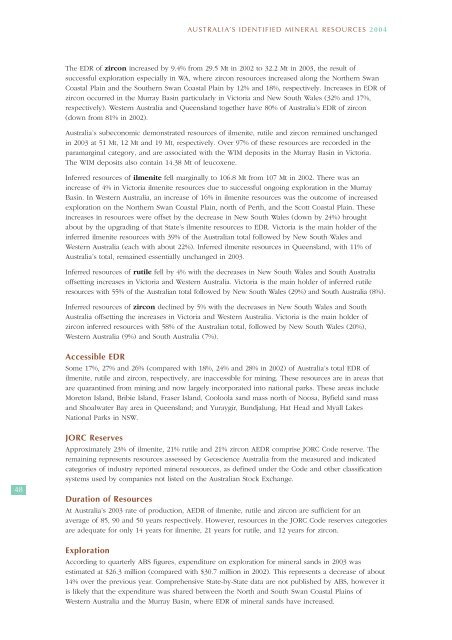australia's identified mineral resources 2004 - Geoscience Australia
australia's identified mineral resources 2004 - Geoscience Australia
australia's identified mineral resources 2004 - Geoscience Australia
Create successful ePaper yourself
Turn your PDF publications into a flip-book with our unique Google optimized e-Paper software.
AUSTRALIA’S IDENTIFIED MINERAL RESOURCES <strong>2004</strong><br />
The EDR of zircon increased by 9.4% from 29.5 Mt in 2002 to 32.2 Mt in 2003, the result of<br />
successful exploration especially in WA, where zircon <strong>resources</strong> increased along the Northern Swan<br />
Coastal Plain and the Southern Swan Coastal Plain by 12% and 18%, respectively. Increases in EDR of<br />
zircon occurred in the Murray Basin particularly in Victoria and New South Wales (32% and 17%,<br />
respectively). Western <strong>Australia</strong> and Queensland together have 80% of <strong>Australia</strong>’s EDR of zircon<br />
(down from 81% in 2002).<br />
<strong>Australia</strong>’s subeconomic demonstrated <strong>resources</strong> of ilmenite, rutile and zircon remained unchanged<br />
in 2003 at 51 Mt, 12 Mt and 19 Mt, respectively. Over 97% of these <strong>resources</strong> are recorded in the<br />
paramarginal category, and are associated with the WIM deposits in the Murray Basin in Victoria.<br />
The WIM deposits also contain 14.38 Mt of leucoxene.<br />
Inferred <strong>resources</strong> of ilmenite fell marginally to 106.8 Mt from 107 Mt in 2002. There was an<br />
increase of 4% in Victoria ilmenite <strong>resources</strong> due to successful ongoing exploration in the Murray<br />
Basin. In Western <strong>Australia</strong>, an increase of 16% in ilmenite <strong>resources</strong> was the outcome of increased<br />
exploration on the Northern Swan Coastal Plain, north of Perth, and the Scott Coastal Plain. These<br />
increases in <strong>resources</strong> were offset by the decrease in New South Wales (down by 24%) brought<br />
about by the upgrading of that State’s ilmenite <strong>resources</strong> to EDR. Victoria is the main holder of the<br />
inferred ilmenite <strong>resources</strong> with 39% of the <strong>Australia</strong>n total followed by New South Wales and<br />
Western <strong>Australia</strong> (each with about 22%). Inferred ilmenite <strong>resources</strong> in Queensland, with 11% of<br />
<strong>Australia</strong>’s total, remained essentially unchanged in 2003.<br />
Inferred <strong>resources</strong> of rutile fell by 4% with the decreases in New South Wales and South <strong>Australia</strong><br />
offsetting increases in Victoria and Western <strong>Australia</strong>. Victoria is the main holder of inferred rutile<br />
<strong>resources</strong> with 55% of the <strong>Australia</strong>n total followed by New South Wales (29%) and South <strong>Australia</strong> (8%).<br />
Inferred <strong>resources</strong> of zircon declined by 5% with the decreases in New South Wales and South<br />
<strong>Australia</strong> offsetting the increases in Victoria and Western <strong>Australia</strong>. Victoria is the main holder of<br />
zircon inferred <strong>resources</strong> with 58% of the <strong>Australia</strong>n total, followed by New South Wales (20%),<br />
Western <strong>Australia</strong> (9%) and South <strong>Australia</strong> (7%).<br />
Accessible EDR<br />
Some 17%, 27% and 26% (compared with 18%, 24% and 28% in 2002) of <strong>Australia</strong>’s total EDR of<br />
ilmenite, rutile and zircon, respectively, are inaccessible for mining. These <strong>resources</strong> are in areas that<br />
are quarantined from mining and now largely incorporated into national parks. These areas include<br />
Moreton Island, Bribie Island, Fraser Island, Cooloola sand mass north of Noosa, Byfield sand mass<br />
and Shoalwater Bay area in Queensland; and Yuraygir, Bundjalung, Hat Head and Myall Lakes<br />
National Parks in NSW.<br />
48<br />
JORC Reserves<br />
Approximately 23% of ilmenite, 21% rutile and 21% zircon AEDR comprise JORC Code reserve. The<br />
remaining represents <strong>resources</strong> assessed by <strong>Geoscience</strong> <strong>Australia</strong> from the measured and indicated<br />
categories of industry reported <strong>mineral</strong> <strong>resources</strong>, as defined under the Code and other classification<br />
systems used by companies not listed on the <strong>Australia</strong>n Stock Exchange.<br />
Duration of Resources<br />
At <strong>Australia</strong>’s 2003 rate of production, AEDR of ilmenite, rutile and zircon are sufficient for an<br />
average of 85, 90 and 50 years respectively. However, <strong>resources</strong> in the JORC Code reserves categories<br />
are adequate for only 14 years for ilmenite, 21 years for rutile, and 12 years for zircon.<br />
Exploration<br />
According to quarterly ABS figures, expenditure on exploration for <strong>mineral</strong> sands in 2003 was<br />
estimated at $26.3 million (compared with $30.7 million in 2002). This represents a decrease of about<br />
14% over the previous year. Comprehensive State-by-State data are not published by ABS, however it<br />
is likely that the expenditure was shared between the North and South Swan Coastal Plains of<br />
Western <strong>Australia</strong> and the Murray Basin, where EDR of <strong>mineral</strong> sands have increased.

















